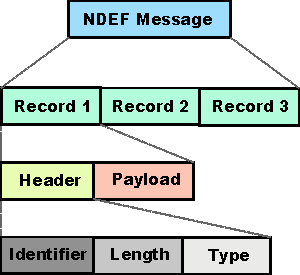NDEF, NFC Data Exchange Format
NFC has its own format for data exchanged, called the NFC Date Exchange Format, NDEF, it governs the way in which data is transferred.
NFC, Near Field Communication Includes:
What is NFC?
NFC technology
NFC RF signal
Data exchange format
NFC Tags & tag types
NFC security
The NFC Data Exchange Format, NDEF is used as a lightweight format for transferring data across an NFC link.
NFC NDEF has been designed to offer a simple yet effective format so that it can be used by both active and passive NFC devices. In this way it can be used for all NFC communication.
Being a lightweight format, NDEF does not add much to the overheard of the messages allowing low data rates to be maintained, thereby saving on power - a crucial requirement for NFC.
The NFC data exchange format is a binary message format that can be used to encapsulate one or more application-defined payloads which may be of a variety of types and sizes. These are combined into a single message construct. Each payload is described by a type, a length, and an optional identifier.
NFC NDEF basics
With many different high level applications needing to transfer data over the NFC radio interface, the concept of the NFC NDEF is to be able to send data of any format over the interface while still being able to retain the air interface data format.
An NDEF message is composed of one or more NDEF records. There can be multiple records in a NDEF message.
The limit for the number of records that can be encapsulated into an NFC NDEF message depends upon the application in use and the tag type used.
In order that the system knows where the messages begin and end, the first record in a message is marked with the MB or Message Begin flag set and the last record in the message is marked with the ME or Message End flag set. The minimum message length is one record. This is achieved by setting both the MB and the ME flag in the same record.
To ensure that the data capability is used efficiently, NFC NDEF records do not incorporate an index number - the index number within the message is implicitly assigned by the order in which the records occur.

It can be seen that the NDEF is exchanged in messages that comprise of a sequence of records.
Each record consists of two parts:
- Header: The header for the NDEF exchange includes indicator for a number of elements:
- Payload length: The payload length is always included in the NDEF header by a specific field. The payload length field is one octet for short records but for normal records it is four octets long. Short records are indicated by setting a flag bit known as the SR or short record flag to a value of 1. Zero is a valid payload length.
- Payload type: The payload type of a record indicates the kind of data being carried in the payload of that record. This may be used to guide the processing of the payload at the discretion of the user application. The format of the Payload Type field value is indicated using the TNF, Type Name Format field.
- Payload identification: An optional payload identifier allows the applications to identify the payload carried within an NDEF record.
- Payload: The payload can be of one of a variety of different types: URL, MIME media, or NFC-specific data type. For NFC-specific data types the payload contents must be defined in an NFC Record Type Definition file, RTD.
NFC NDEF provides a straightforward format for exchanging data over an NFC link. It has little overhead in terms of additional data requiring to be transferred and as such is ideal for the low power NFC environment.
 Written by Ian Poole .
Written by Ian Poole .
Experienced electronics engineer and author.
Wireless & Wired Connectivity Topics:
Mobile Communications basics
2G GSM
3G UMTS
4G LTE
5G
Wi-Fi
Bluetooth
IEEE 802.15.4
DECT cordless phones
Networking fundamentals
What is the Cloud
Ethernet
Serial data
USB
LoRa
VoIP
SDN
NFV
SD-WAN
Return to Wireless & Wired Connectivity



